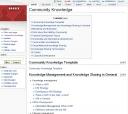 This is the second in my latest series of online facilitation method tips and mini-podcasts. John Smith asked me to write up the practice some of us have been nurturing on the KM4DevWiki to encourage summarizing and harvesting of learnings from key community conversations in our email list on to a wiki. The podcast can be found here.
This is the second in my latest series of online facilitation method tips and mini-podcasts. John Smith asked me to write up the practice some of us have been nurturing on the KM4DevWiki to encourage summarizing and harvesting of learnings from key community conversations in our email list on to a wiki. The podcast can be found here.
There are often amazing threads on email lists and web based discussions. Often they get lost due to the tyranny of recency over relevancy. We remember what we last read. How many times have you heard people say “hey, we discussed that before… where IS that conversation?” Some tools make it easy to search within message, but then you have to reconstruct a thread. There may have had subject line changes, interruptions, etc. It is hard work. That’s why it is useful think about practices to pull out useful stuff so it can provide wider and easier benefit.
One practice of harvesting learnings from text based discussions (in email or web forums) started as a small FAQ (frequently asked questions) project a small group of use did a couple of years ago as part of the KM4Dev community. KM4Dev is a global community of practice interested in knowledge management and knowledge sharing in international development.
We initially intended to create FAQ’s out of key discussions to answer what we thought were some of the “big questions” that often came up in the community. You can read about the project at the following links.
- FAQIntro – about the FAQ project
- Community Knowledge – what the FAQ project turned in to.
- FAQ Template – the template use – which is now simpler than our earlier versions.
- FAQ Team Meeting Notes – our FAQ team telephone meeting notes
- FAQtory Process Observations – our observations and reflections on doing this project
- FAQ Project After Action Review
- Community Questions and Comments – community feedback.
What we discovered was that often something wasn’t simply a response to a question, so the FAQ format started to limit us. We moved into harvesting what we called “Community Knowledge.” This is the basis of the technique I know use regularly.
Now, on the the technique. (Did I say these were going to be short? I guess I goofed on that!)
- Role model the harvesting behavior. Our initial FAQs gave people the chance to experience discussion summaries. But the next step was to role model it around current discussions. At first we would notice a “hot thread,” summarize it then post the wiki url back to the email list.
- Templates can make it easier/more comfortable for people new to summarization and/or wikis.
- Cross promote the wiki on the list to keep it in the community “line of sight.”
- Ask others to try the behavior. Next we started asking people to create and post their own summaries of discussion threads that they started.
- asking in a private email is friendlier, but sometimes the public request can add some useful “pressure.”
- Time the request well. Usually we made the request for summarization after we saw a thread really get going — and hopefully near the end of the thread.
- I have made the mistake of suggesting that the thread be summarized too soon and people took that as a “stop talking” signal.
- Expect resistance. (And I’m tempted to say “resistance is futile, but that’s not really true!) Initially people did not summarize. So I would set up a wiki page for them, send them the url and another small request. (I think I started signing my emails from “wikipest.”) Some people would then summarize and post to the wiki, and some would send me the summary to post. That was fine.
- Reminders are often useful. I do wonder if I annoyed some times…
- Encourage those who adopt the practice. After about a year, others started recommending a summaries to starters of hot threads. So the initial part of the practice was being picked up by others. More people were creating pages, but it was still a very limited group.
- Don’t expect miracles
- Do thank those wonderful souls who will do this important community work.
- Make the value visible. Last year we had the need to review our technical platforms and lo and behold, the wiki was getting more page views that the community’s older, established content management based site. This validated that people were finding and in some way, interested in what we had harvested. I believe this external validation helped motivate and maintain the practice.
- Share stories of use
- Make pageview data available
- If the wiki has been useful beyond the community, get the other users to send a thank you as well.
- Reduce barriers and support from the side. Some of us still have to go in and link pages to the index page.
- We have had to require registration for the wiki due to wiki-spam, which creates some friction and overhead – it is not as easy as I wish it were.
- The wiki still needs a lot of overall attention to make things easier to find. (That is on my to do list – and has been for a long time. )
All in all, the practice is valued. We are making our knowledge visible and available to the wider world and inviting them to help improve it. There are 76 entries. The entries on knowledge sharing tools and methods have been spread and reused by members’ parent organizations. Value has been amplified. I think it was worth it!
For more on harvesting:
- The Art of Hosting (paper .dco)

 Yesterday I was interviewed about “making mistakes in public” and how that allows us to get feedback and learn from others. My friend Philip Tarlow mentioned this Picasso quote to me last week, and it struck me as being about our learning edges. Doing things we aren’t quite sure we know how to do. Taking risks in the name of learning and doing.
Yesterday I was interviewed about “making mistakes in public” and how that allows us to get feedback and learn from others. My friend Philip Tarlow mentioned this Picasso quote to me last week, and it struck me as being about our learning edges. Doing things we aren’t quite sure we know how to do. Taking risks in the name of learning and doing.